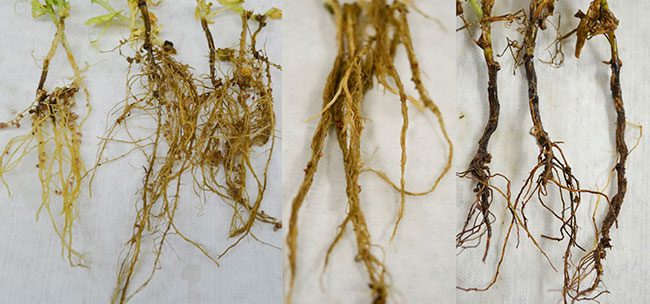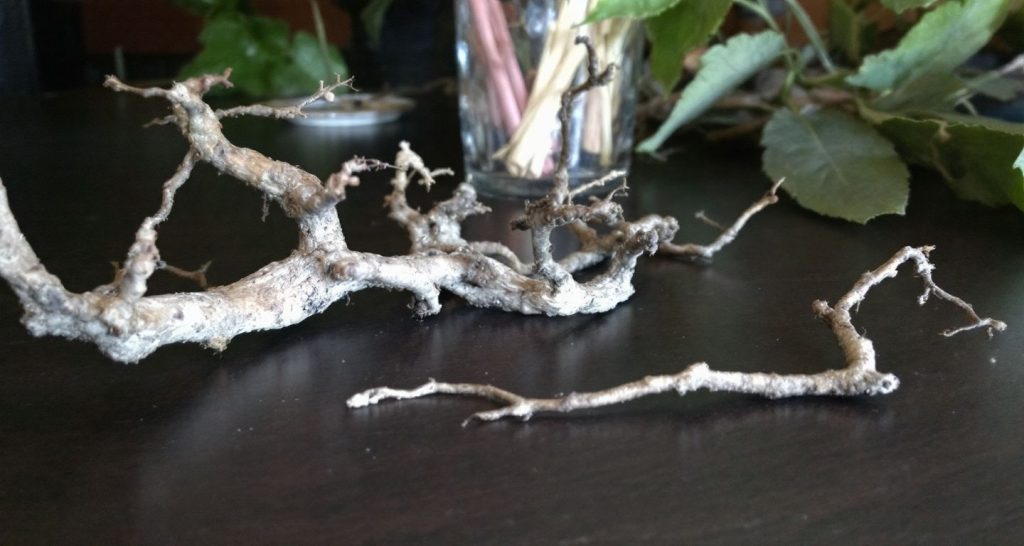Did you know that 50% of houseplant deaths are due to root rot? This problem can quietly harm your indoor plants, starting with the roots. But, with the right knowledge, you can save your plants.
Key Takeaways:
- Root rot is a common issue caused by overwatering and poor drainage, leading to bacterial and fungal infections
- Early signs include stunted growth, wilting leaves, and yellowing lower leaves, progressing to brown leaves and stem rot
- Inspect plant roots regularly – healthy ones are white and firm, while rotted roots are mushy, dark, and smelly
- Treat root rot by removing affected roots, repotting in fresh soil, and adjusting the watering schedule
- Prevent future issues by using well-draining soil, proper watering techniques, and quarantining new plants
What is Root Rot?
Root rot is a serious problem for plants. It happens when roots decay from too much water. This is because of too much water and poor soil drainage. Harmful bacteria and fungi like Pythium and Phytophthora grow and attack the roots.
Plant roots need the right mix of water and air. Too much water makes the roots lack oxygen and rot. This leads to stunted growth, wilting leaves, and yellowing foliage. If not treated, it can kill the plant.
Some key facts about root rot:
- Root rot is common in both indoor and outdoor plants. It affects those in poorly drained soil or too much water.
- Fungi like Pythium, Phytophthora, Rhizoctonia, Fusarium, and Armillaria cause root rot.
- Early signs include stunted growth, wilting leaves, and yellowing leaves. As it gets worse, leaves turn brown, die, and fall off.
- Healthy roots are white and firm. Rotten roots are mushy, dark, and smell bad.
Knowing the causes and signs of root rot is key. It helps prevent and treat the problem early. Many plants can recover and grow well again with the right care.
Causes of Root Rot
Keeping the right balance of moisture and air is key for healthy roots. When soil gets too wet, it’s a breeding ground for harmful bacteria and fungi. This leads to root rot, a big problem for plants.

Overwatering and Poor Drainage
Overwatering is a major cause of root rot. Plants in waterlogged soil with poor drainage lack oxygen. This is perfect for bacteria and fungi like Pythium and Phytophthora to grow and harm the roots.
Unhealthy Soil Conditions
Plants in poor health are more likely to get root rot. Issues like compacted soil, lack of nutrients, and too much salt weaken roots. This makes them easy targets for infections. Good soil care is essential to avoid root rot.
| Statistic | Value |
|---|---|
| Overwatering as the most common cause of root rot | Overwatering is the most common cause of root rot in indoor plants. |
| Unhealthy plants more susceptible to root rot | Unhealthy plants are more susceptible to root rot. |
| Fungi that cause root rot | Various fungi can cause root rot, including Armillaria mellea, Clitocybe tabescens, and Fusarium. |
Knowing the main causes of root rot helps gardeners and plant lovers prevent it. This way, they can keep their indoor plants healthy and thriving.
Signs of Root Rot
As a plant lover, knowing the early signs of root rot is key. This common problem can harm your indoor plants. Spotting these signs early can help save your plants.
Early Indicators
One early sign is stunted growth. If your plant isn’t growing as it should, it might be a problem. Also, wilting leaves after watering can be a warning. It shows the roots are not getting enough water and nutrients.
Yellowing of older or lower leaves is another sign. This happens when the roots can’t move nutrients and water well. It leads to leaves turning yellow and falling off too soon.
Progression of Symptoms
As root rot gets worse, the signs get clearer. Leaves may turn brown and start to die off. Eventually, they will drop. This means your plant is very sick and needs help fast.
By watching for these signs, you can act quickly. Fixing the root problem and caring for your plants properly can help them get better. This way, your plants can thrive again.
How to Check for Root Rot
As a plant lover, checking for root rot is key to a healthy indoor garden. This fungal disease can harm your plants fast if not caught early. Knowing the signs and how to check roots is crucial for your plants’ health.
Inspect the Roots
Start by carefully taking your plant out of its pot to check the roots. Healthy roots are white and firm, showing a strong plant. But, if roots are mushy, dark, or smell bad, your plant has root rot and needs help fast.
- Healthy roots are white and firm
- Rotted roots are mushy, dark brown/black, and have an unpleasant odor
By inspecting the plant roots regularly, you can spot root rot early. This helps save your plants and keeps your indoor garden healthy for years.
“Regularly checking the health of your plant’s roots is the best way to stay ahead of root rot and keep your indoor garden flourishing.”
Root Rot
Root rot is a serious problem that can spread quickly. It affects indoor plants and can be carried by pests like fungus gnats. It’s important for plant owners to watch out for it.
Soil-Borne Transmission
Fungi like Pythium and Phytophthora can live in soil for a long time. If the soil is infected, the disease can spread to other plants. This can happen when you repot or transplant.
Water-Borne Spread
Root rot can also spread through water. If the water has fungal spores, it can infect your plants. Make sure your watering doesn’t spread the disease.
Air-Borne Transmission
In some cases, root rot spores can get airborne. This lets the disease move from plant to plant through the air. This can happen if the soil is disturbed or if plants are close together.
Pest-Assisted Transmission
Fungus gnats can also help spread root rot. These pests carry fungal spores on their bodies. They can move these spores to other plants, making the problem worse.
It’s key to be careful and prevent root rot from spreading. Knowing how it spreads helps you protect your plants. This way, you can keep your indoor plants healthy and thriving.
Immediate Treatment Steps
If your indoor plant shows signs of root rot, you must act fast. The first steps are to remove rotted roots, repot in fresh soil, and adjust your watering. These actions are crucial to save your plant.
1. Remove Rotted Roots
Begin by carefully taking the plant out of its pot. Look at the roots. Healthy roots are white and firm. Rotted roots are mushy, dark, and smell bad.
Use clean tools to cut away the bad roots. Make sure to remove all diseased parts.
2. Repot in Fresh Soil
Once you’ve removed the bad roots, it’s time to repot. Put the plant in a clean pot with new, draining soil. This stops the rot from spreading and helps the plant grow.
3. Adjust Watering Schedule
Overwatering often causes root rot. So, you need to water less. Only water when the top inch of soil is dry. Make sure the soil drains well to avoid waterlogging.
By taking these steps – removing bad roots, repotting, and adjusting watering – you can help your plant recover. This way, you can prevent root rot from happening again.
Preventing Root Rot
Keeping your indoor plants healthy begins with the right watering and soil. Too much water is the main cause of root rot. It creates a perfect spot for harmful bacteria and fungi to grow and harm your plants’ roots.
To stop root rot, follow these key steps:
- Use well-draining soil: Pick a potting mix that drains well. This stops water from making the soil too wet and causing root rot.
- Opt for pots with drainage holes: Make sure your plant’s pots have lots of holes. This lets extra water out, keeping the roots healthy.
- Water plants based on their needs: Adjust how often you water based on the plant, season, and environment. It’s better to underwater than overwater, as root rot loves wet soil.
- Quarantine new plants: Keep new plants separate for a few weeks. This helps spot any diseases or pests before they spread to your other plants.
By taking these steps, you can prevent root rot. This keeps your indoor plants healthy and thriving for a long time.
| Cause of Root Rot | Percentage Contribution |
|---|---|
| Overwatering | 65% |
| Soil-borne Fungi and Bacteria | 25% |
| Other Factors (Drainage, Humidity, etc.) | 10% |
By tackling the main causes of root rot, you can protect your indoor plants. This way, they can grow lush and healthy for many years.
Root Rot Recovery
Many plants can recover from root rot with the right treatment. The damage’s severity affects the plant’s recovery chances. In mild cases, plants can bounce back in 1-2 weeks. This is by removing bad roots, repotting in fresh soil, and adjusting watering.
But, plants with severe root rot might not recover. If most of the roots are damaged, starting over with healthy cuttings is best. This way, the plant can grow strong again.
Quick action and the right care are crucial for recovery. With patience, many plants can fully recover. Keeping plants healthy with proper care prevents root rot.


